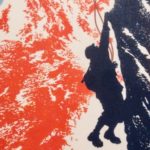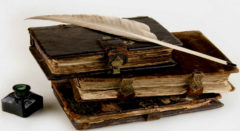About › Forums › Den of Writers › Blogs › The $2,000,000 Guitar
- This topic has 8 replies, 6 voices, and was last updated 3 years, 9 months ago by
 Doug.
Doug.
-
AuthorPosts
-
March 11, 2020 at 7:56 pm #7931
 RichardBParticipant
RichardBParticipant$2,000,000? Who’d be crazy enough to pay that for a guitar? Kirk Hammett of Metallica, apparently. He did just that in 2016, so the story goes, for a fifty-seven-year-old Gibson Les Paul.
What possessed him, you may be thinking, to do such a thing?
Let’s start from the beginning.
In 1952, following the trend set by Fender, the Gibson Guitar Corporation introduced the Les Paul, their first solid-body electric guitar. Gibson would not compromise their reputation as high-quality musical instrument makers and so the Les Paul was much more expensive (and much heavier) than the Fender models it was competing against. Its traditional guitar shape and styling also looked rather old-fashioned beside the revolutionary space-age modernity of a Fender. Sales were disappointing and the model was dropped in 1961.
That might have been the end of the story, but then something happened that Gibson didn’t expect. A new generation of guitarists, mostly of a bluesy persuasion and mostly British, found the sound of the Gibson Les Paul very much to their taste. Keith Richards began playing one in 1964, and soon nearly all of the first wave of guitar heroes were using second-hand Les Pauls – among them Jeff Beck, Jimmy Page, the tragic Paul Kossoff of Free and, most influentially, Eric Clapton. Clapton has been wedded to the Fender Stratocaster for nearly fifty years now, but back in his youth, when he was in John Mayall’s Bluesbreakers and people were writing ‘Clapton is God’ on walls, he played a Gibson Les Paul. That was what he used to produce the blistering, fiery and hugely influential guitar work on the 1966 John Mayall record known as the ‘Beano Album’ – because Clapton is reading a copy of the Beano in the cover photo.
Suddenly Les Pauls were in demand. Gibson began making them again in 1968 and the model has been in production ever since. But, even without the changes of company ownership and the quality compromises that followed, it was predictable that the original, pre-1961 guitars would come to be regarded as superior to the new ones. Add to the mix their comparative rarity – sales were disappointing, remember – and you had the perfect formula for prices to skyrocket – which they duly did.
Even so, $2,000,000 is a bit extreme. What’s so special about this particular Gibson Les Paul?
Well, for a start it’s not the guitar Eric Clapton played on that John Mayall album: that was stolen from him and nobody – nobody, that is, who’s saying – knows where it is now. But Clapton had left the Bluesbreakers to form Cream even before the album came out, and his replacement was a young man by the name of Peter Green, who soon started building a reputation of his own. And yes, he also played a Gibson Les Paul.
Peter Green didn’t stay very long in the Bluesbreakers either, and in 1967 he left to form his own blues band. Green was (and is) a singularly ego-less person and, trying to avoid pedestal status, he named his band after its rhythm section, drummer Mick Fleetwood and bass player John McVie.
Everybody has heard of Fleetwood Mac, but not so many know that they began their career as a straight blues band, playing in the blues clubs that flourished in the late sixties, mostly in the back rooms of pubs. It wasn’t long before they outgrew that scene, expanding their musical horizons and scoring several British chart hits, including a number one with the moody instrumental Albatross. They went on, of course, to conquer the world with one of the biggest-selling albums of all time.
But not with Peter Green. The sensitivity that gave his music its power ill-fitted him to cope with fame and fortune. Too much LSD didn’t help. In 1970 he dropped out of the band he’d formed and out of sight into a twilight world of mental problems. Diagnosed with schizophrenia, he spent years in and out of hospitals. He did eventually find some sort of equilibrium, and ever since he has kept a low profile, living quietly and performing now and then, but never with the fire of his youth – probably due to the medication he has to keep taking to stay on an even keel.
So, a sad and almost forgotten footnote to the history of one of the world’s most successful bands? Not quite. Peter Green still makes regular appearances in lists and polls of the greatest guitarists. Many other guitarists have cited him as an inspiration and influence. His playing wasn’t flashy: instead of spraying notes out all over the place, Green played with consummate feeling and perfect phrasing, making every note count. The legendary blues guitarist B B King once said that Peter Green was the only white player who could bring him out in a sweat.
The instrument with which Peter Green did this was a 1959 Les Paul Standard, arguably the most sought-after of all Les Paul models. But that’s not the end of it. Green’s guitar was not quite like any other Les Paul, having a unique tone, supposedly the result of being wired-up incorrectly after a repair. It was quite in character that he sold it in 1974 for a modest price to Gary Moore, who used it for many years. Gary Moore is no longer with us, and this is the guitar that Kirk Hammett paid that reported $2,000,000 for in 2016.
It would be interesting to know what Peter Green thinks of all this. My best guess is that he couldn’t give a toss.
And what’s my interest in this, apart from sheer nerdiness?
I was one of the people who were blown away by Eric Clapton’s playing on that Beano Album. It was the first album I ever bought and I still have it, though these days I’ll play it on CD if I want to hear it again. And when I do, after all these years Clapton’s playing can still raise the hairs on the back of my neck. For my money (sorry, Mr C), he never again played with quite such power, such fire and conviction, with such sheer oomph.
Ever since I’d first been given a hint of what it was like by the Rolling Stones early efforts, I’d had a taste for the blues. None of my friends were impressed by Little Red Rooster, their bluesiest hit, but I loved it. From the moment I heard the first notes of that Mayall album I felt that this was the music I’d been waiting to hear. I became a born-again blues fanatic, and when a blues club opened up in a pub in Croydon, a short train ride from where I lived then, I started going there. The venue was too small to afford John Mayall, but I saw many of the other blues bands who were doing the rounds then: Savoy Brown, Ten Years After, Chicken Shack (who featured a young lady on piano and vocals called Christine Perfect). And I saw Fleetwood Mac there, two or three times, and they were special, head and shoulders above the rest.
Though they drew their inspiration from the same source as the other bands on that circuit, the amplified Chicago blues of the nineteen-fifties, there was a magic about their performances that set them apart. Even now I can’t define exactly what that magic was, save that it centred upon Peter Green, and it never seemed to quite make it onto the band’s early records, but it was real enough. And, in between numbers and sometimes during them too, they were risqué, cheeky, funny. At encore time they’d switch to classic fifties rock’n’roll, steaming through one stomper after another and ignoring the promoter’s attempts to call time on them until he was tearing his hair out. They were having a ball and so were we in the audience. I still remember those evenings with Fleetwood Mac in the back room of a scruffy pub in Croydon as the best gigs I ever went to.
In retrospect I realise that I was fortunate enough to catch a band at exactly the right moment, when it was just about to make it big. I first heard Albatross in the back room of another pub, the Toby Jug by the Kingston By-pass at Tolworth. The next time I saw Fleetwood Mac after that they were at the Royal Albert Hall supporting B B King.
But I would never in a million years have guessed, as I sat in that crowded little room in Croydon with the condensation running down the walls, that the guitar with which Peter Green was spellbinding an audience of possibly two hundred people would one day change hands for $2,000,000.
Oh, and yes, I still love the blues.
March 11, 2020 at 8:25 pm #7932 DaedalusParticipant
DaedalusParticipantWow. Magical stuff!
March 12, 2020 at 9:36 am #7934 SquidgeParticipant
SquidgeParticipantBlimey – and I think my son’s nuts for setting his sights on a bass that’s selling for £5K!
Mind you, he’s got one custom built bass, courtesy of Mr Squidge, and apparently he plans to build another custom ‘normal’ guitar this summer, so who knows what they’ll be worth in years to come…?
March 12, 2020 at 10:01 am #7936 Mad IguanaParticipant
Mad IguanaParticipantThat’s a brilliant story, Richard. Absolutely love it!!
March 12, 2020 at 11:13 am #7939 RichardBParticipant
RichardBParticipantGod, the nostalgia. It’s all coming back to me…
A couple of little snippets from that Croydon club:
I was still at school and couldn’t afford to go there every week, so on weeks when lesser-known bands were billed I didn’t bother. Apparently I wasn’t the only one. One night the promoter got up on his hind legs at the beginning of the evening and said, ‘You lot stayed away last week, didn’t you? Well, you missed something. The band was really good. There was this funny bloke with a flute…’
I wasn’t at all surprised when I heard that Christine Perfect of Chicken Shack had become Christine McVie. Not after I’d arrived at the pub for a Chicken Shack gig to see her sitting chatting quietly with John McVie (and no, Fleetwood Mac were not playing that night) at a table in a corner of the bar.
Oh yes, and the previous year, before I’d started going there, Jimi Hendrix, no less, had played in that back room.
March 12, 2020 at 3:38 pm #7940 John S AltyParticipant
John S AltyParticipantGreat story.
July 25, 2020 at 6:59 pm #8586 RichardBParticipant
RichardBParticipantSadly, I have heard today that Peter Green, without whom this blog wouldn’t have been written, has died at the age of 73.
July 25, 2020 at 11:50 pm #8587 Mad IguanaParticipant
Mad IguanaParticipantI saw that and thought of your post, and your memories.
July 26, 2020 at 9:53 pm #8594 DougParticipant
DougParticipantSuch a great story! As a guitarist who at one time owned a Les Paul, I found it fascinating. I’d also like to add that, for one of the greatest all-time guitar leads–the Beatles’ “While My Guitar Gently Weeps”–Eric Clapton knocked it out in one take, with a red Les Paul he called Lucille. Wonderful stuff.
-
AuthorPosts
- You must be logged in to reply to this topic.
